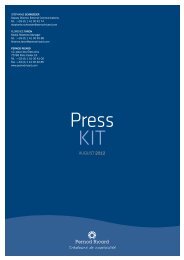Registration Document - Pernod Ricard
Registration Document - Pernod Ricard
Registration Document - Pernod Ricard
You also want an ePaper? Increase the reach of your titles
YUMPU automatically turns print PDFs into web optimized ePapers that Google loves.
16.2 Investment-related l oans<br />
and receivables<br />
This category mainly includes investment-related loans and<br />
receivables, current account advances granted to non-consolidated<br />
entities and associates and guarantee deposits. The loans and<br />
receivables related to these investments are measured at their<br />
impaired cost value.<br />
16.3 Trade receivables<br />
Trade receivables are recognised initially at their fair value, which is<br />
usually their nominal value. Impairment losses are recognised where<br />
there is a risk of non-recovery.<br />
16.4 Cash and cash equivalents<br />
In accordance with IAS 7 (Cash flow statements), cash and cash<br />
equivalents presented in assets and liabilities in the balance sheet<br />
and shown in the statement of cash flows include items that are<br />
immediately available as cash or are readily convertible into a known<br />
amount of cash and which are subject to an insignificant risk of<br />
change in their value. Cash is composed of cash at bank and on hand,<br />
short-term deposits with an initial maturity of less than three<br />
months and money-market mutual funds that are subject to an<br />
insignificant risk of change in their value. Cash equivalents are<br />
short-term investments with a maturity of less than three months.<br />
Bank overdrafts, which are considered to be equivalent to financing,<br />
are excluded from cash and cash equivalents.<br />
17. Treasury shares<br />
Treasury shares are recognised on acquisition as a deduction from<br />
shareholders’ equity. Subsequent changes in the value of treasury<br />
shares are not recognised. When treasury shares are sold, any<br />
difference between the acquisition cost and the fair value of the<br />
shares at the date of sale is recognised as a change in shareholders’<br />
equity and has no impact on profit and loss for the year.<br />
18. Provisions<br />
18.1 Nature of provisioned liabilities<br />
In accordance with IAS 37 (Provisions, contingent liabilities and<br />
contingent assets), provisions are recognised to cover probable<br />
outflows of resources that can be estimated and that result from<br />
present obligations relating to past events. In the case where a<br />
potential obligation resulting from past events exists, but where<br />
occurrence of the outflow of resources is not probable or where<br />
the amount cannot be reliably estimated, a contingent liability is<br />
disclosed among the Group’s commitments. The amounts provided<br />
are measured taking account of the most probable assumptions or<br />
using statistical methods, depending on the nature of the obligations.<br />
Provisions notably include:<br />
◆ provisions for restructuring;<br />
◆<br />
◆<br />
provisions for pensions and other long-term employee benefits;<br />
provisions for litigation (tax, legal, employee-related).<br />
Litigation is kept under regular review, on a case-by-case basis, by the<br />
legal department of each subsidiary or region or by the Group’s legal<br />
department, drawing on the help of external legal consultants in the<br />
ANNUAL CONSOLIDATED FINANCIAL STATEMENTS 4<br />
Notes to the annual consolidated fi nancial statements<br />
most significant or complex cases. A provision is recorded when it<br />
becomes probable that a present obligation arising from a past event<br />
will require an outflow of resources whose amount can be reliably<br />
estimated. The amount of the provision provided is the best estimate<br />
of the outflow of resources required to extinguish this obligation.<br />
18.2 Provisions for restructuring<br />
The cost of restructuring is fully provided for in the financial year, and<br />
is recognised in profit and loss within other income and expenses ,<br />
when it is material and results from a Group obligation to third parties<br />
arising from a decision taken by the appropriate board that has<br />
been announced to the third parties in question before the balance<br />
sheet date. This cost mainly involves redundancy payments, earlyretirement<br />
payments, costs of notice periods not served, training<br />
costs of departing individuals and costs of site closure. Scrapping of<br />
property, plant and equipment, impairment of inventories and other<br />
assets, as well as other costs (moving costs, training of transferred<br />
individuals, etc.) directly related to the restructuring measures are<br />
also recognised in restructuring costs. The amounts provided for<br />
correspond to forecasted future payments to be made in connection<br />
with restructuring plans, discounted to present value when the<br />
timetable for payment is such that the effect of the time value of<br />
money is significant.<br />
18.3 Provisions for pensions and other<br />
long-term employee benefits<br />
In accordance with applicable national legislation, the Group’s<br />
employee benefit obligations are composed of:<br />
◆ long-term post-employment benefits (retirement bonuses,<br />
◆<br />
pensions, medical and healthcare expenses, etc.);<br />
long-term benefits payable during the period of employment.<br />
Defined contribution plans – Contributions are recognised as<br />
expenses as they are incurred. As the Group is not committed beyond<br />
the amount of such contributions, no provision is recognised in<br />
respect of defined contribution plans.<br />
Defined benefits plans – For defined benefit plans, the projected unit<br />
credit method is used to measure the present value of defined benefit<br />
obligations, current service cost and, if applicable, past service<br />
cost. The measurement is made at each balance sheet date and the<br />
personal data concerning employees is revised at least every three<br />
years. The calculation requires the use of economic assumptions<br />
(inflation rate, discount rate, expected return on plan assets) and<br />
assumptions concerning employees (mainly: average salary increase,<br />
rate of employee turnover, life expectancy). Plan assets are measured<br />
at their market value at each annual balance sheet date. The balance<br />
sheet provision corresponds to the discounted value of the defined<br />
benefit obligation, adjusted for unrecognised past service cost and<br />
unrecognised actuarial gains and losses, and net of the fair value of<br />
plan assets. Actuarial gains and losses mainly arise where estimates<br />
differ from actual outcomes (for example between the expected value<br />
of plan assets and their actual value at the balance sheet date) or when<br />
changes are made to long-term actuarial assumptions (for example:<br />
discount rate, rate of increase of salaries). In the case of long-term<br />
benefits payable during the period of employment (such as longservice<br />
awards), any actuarial gains and losses are fully recognised at<br />
each balance sheet date. In other cases, actuarial gains and losses are<br />
only recognised when, for a given plan, they represent more than 10%<br />
of the greater of the present value of the benefit obligation and the<br />
I REFERENCE DOCUMENT 2008/2009 I PERNOD RICARD 85
















